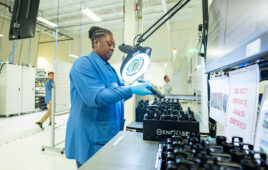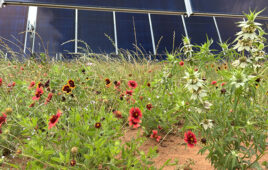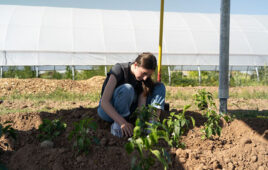By Auston Taber, CEO, Solar Support, and Clifford Myers, PE, director of restoration, DEPCOM Power
It’s easy to go into panic mode when severe weather like tornadoes or fires damage a solar project. Keeping some key advice in mind will limit downtime and get projects back to full operation.
Prioritize safety
Every step of remediation must build safety into the equation. From the first moments of inspecting a damaged site to the final walkthrough after restoration is complete, safety protocols are key.
Restoration projects are uniquely complicated, and few of the workers on-site will have done this kind of repair work previously. There is no off switch for a solar panel. Live wires may be dangling in unexpected locations. Heavy equipment may not be secured in place. As work progresses, new hazards may arise unexpectedly. Beware!
In addition to ensuring that every worker has a pristine safety record, ongoing worker training and site safety inspections should be built into every step of the process. Each worker should be given a site orientation as they begin each stage of the project, even if they’ve worked on earlier stages. Restoration work means ongoing dynamic changes throughout the site.
Dodge speed traps
Time poses the biggest risk in any restoration project. Although the insurance payments for lost production may create a false sense of security, those payments won’t continue indefinitely. Start as soon as possible — at the very least with clean-up operations.
But don’t prioritize speed over everything else. Only start deconstructing damaged areas after you get audit guidelines from the manufacturers to determine whether parts are salvageable. And don’t take a partially operating plant offline to begin work until you have all necessary materials onsite. Shipping delays could derail your operation, causing you to stop generating power far sooner than necessary and resulting in higher than expected generation and revenue losses.
Even as restoration work begins, continue to reassess what needs to be done and when. While you might have looked at cabling and decided all the wiring must be thrown out, you may find parts that can be reused as you go along. Or you may find that an entire site was done with the wrong connectors in the first place, which means re-doing all of them site-wide. A plant restoration expert isn’t going to simply restore the site; they’re going to make it better than it was.
Ensure human resources match site needs
Maintain a clear schedule with daily and weekly visibility. Define key milestones and make sure everyone tracks progress toward meeting them. Include all subcontractors and contractors in every assessment; transparency can smooth out problems before they become serious.
That transparency includes ensuring all workers are in the correct place. It doesn’t matter if a subcontractor has an excellent reputation if they’re assigning their JV squad to your project while their sharpest workers are building new sites.
Restoration requires detail-oriented, organized, punctual individuals with experience in salvage, repair and replacement who understand how to respond to a site’s evolving needs.
What to look for in an O&M partner
Site remediation after an extreme weather event is a tricky business. While many O&M providers will attempt it, few have the boots-on-the-ground experience required to ensure complete and timely asset recovery while maximizing insurance payout.
Look for a restoration expert with broad capabilities that knows what can be salvaged and what needs to be replaced. Make sure it has the extensive networks required to source hard-to-find components or to manufacture out-of-production parts.
Find a capable O&M partner accustomed to coordinating talent across multiple disciplines so they can be your single point of contact. Experience, reputation and financial viability are all key to a successful O&M relationship.
Read Part 1 for six steps to save utility-scale solar projects after extreme weather damage.
Auston Taber has spent nearly 15 years in the solar industry across various technical and service roles, offering deep expertise in PV equipment and site O&M across residential, C&I and utility environments. Auston’s experience resolving complex inverter and plant O&M issues spans leadership roles across customer service, safety and training with companies such as SMA, Huawei and Ginlong Technologies. In founding Solar Support, Auston combines equipment repair, component supply and plant restoration to rebuild utility-scale systems while minimizing losses for investors.
Clifford Myers, a Navy Veteran, drives restoration excellence, bringing his expertise in solar systems fault resolution and performance optimization to DEPCOM Power. With over 14 years combined experience in utility PV technology and power conversion systems, Cliff steers the company’s restoration, repowering and recertification strategies. Cliff graduated Magna Cum Laude from Arizona State University with a Bachelor of Science in Electrical Engineering. Cliff is also the co-founder of Solar Support.







Tell Us What You Think!